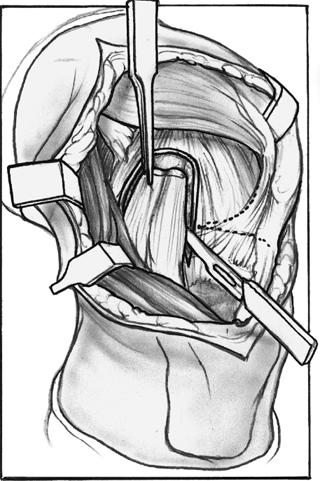Ligament Advancement in Total Knee Arthroplasty
Patient Presentation and Symptoms
- Knee degenerative arthritis
- Severe valgus deformity and medial thrust
- Severe varus deformity and lateral thrust
Indications
- Severe valgus deformity with elongation of the medial supporting structures
- Severe varus deformity with elongation of the lateral supporting structures
- Soft tissue release to correct deformity will cause undesirable leg lengthening.
- Well-fixed components with collateral instability
- Failed constrained implant due to soft tissue imbalance
Contraindications
- Inadequate supporting ligaments
- Inadequate bone stock
Physical Examination
- Alignment
- Range of motion
- Collateral stability
- Muscle strength
- Neurovascular status
- Gait
Diagnostic Tests
- Radiographs: anteroposterior (AP), lateral, and Merchant skyline view
- Long-standing radiograph that includes the hip, knee, and ankle
Special Instruments
- Drill
- Screws and washers
- Bone staples
- No. 5 nonabsorbable suture material
Anesthesia
Epidural with intravenous sedation, or general anesthesia
Patient Position
Supine with the involved leg draped free
Surgical Procedure
Surgical Approach
- Standard midline skin incision
- Medial parapatellar arthrotomy
Medial Ligament Advancement
- Exposure of the medial epicondyle
- Incise around the medial supporting structures including the deep and superficial medial collateral ligament and the posterior oblique ligament.
- The flap is released proximally and elevated subperiosteally in a distal direction.
- The flap created is trapezoidal in shape. The superficial medial collateral ligament is anterior and the posterior oblique ligament is posterior (Fig. 45–1).
- The medial ligament advancement is performed after fixation of the final components.1,2
- With No. 5 nonabsorbable suture material, two locking stitches are placed in the medial flap (Fig. 45–2).
- Soft tissue proximal to the medial epicondyle is elevated to allow the advanced tissue to sit on bare bone.
- The medial flap is advanced proximally and anteriorly.
- The sutures are tied around a screw and washer. 10. A staple is placed at the medial epicondyle to fix the ligament at the center of rotation (Fig. 45–3).

Stay updated, free articles. Join our Telegram channel

Full access? Get Clinical Tree








